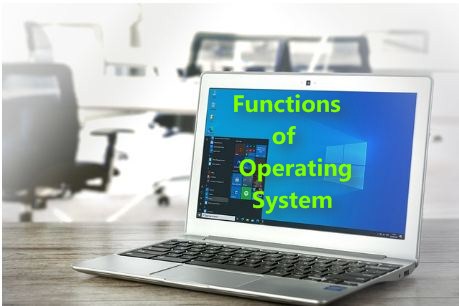The following functions are performed by Operating System:

- Process Management
CPU can perform one task at one time. If there are many tasks, operating system decides which task should get the CPU first.
- This function involves managing and controlling multiple processes or tasks running on the computer’s CPU (Central Processing Unit).
- The operating system decides which process should have access to the CPU and for how long, through a process scheduling algorithm.
- It ensures that processes run efficiently, are allocated appropriate resources, and do not interfere with each other.
- Main Memory Management
Operating system manages memory (RAM)for many running programs. It allocates memory area to different programs. It de-allocates the memory area when a program is terminated.
- Secondary Storage Management
Operating system manages secondary storage. It manages the stored files and folders on disk in a proper way.
- This function involves managing data storage on secondary storage devices like hard drives, SSDs, and external storage.
- The OS manages files and directories, including creating, reading, writing, and deleting files.
- It ensures efficient use of storage space and manages file access permissions.
- I/O System management
It manages Input/output operations. It controls I/O devices like mouse, keyboard, monitor and printer etc.
- The operating system controls Input/Output (I/O) operations between the CPU and external devices like keyboards, mice, monitors, printers, and storage devices.
- It provides an interface for programs to interact with these devices, ensuring that data is transferred correctly and efficiently.
- File Management
It manages files for example creation and deletion of files.
- Protection System
There are many processes of different users in memory at a time. So operating system provides protection so that no process can interfere with another process activity.
- Networking
Operating system provides access to shared resources by networking system.
- Command Interpreter system
Operating system provides command interpreter for reading and executing user commands.
- Booting
Operating system starts the computer to work. It checks the computer and makes it ready to work.
- Loading and Execution
Operating system provides the facility to load programs in memory easily and then execute it.
- Data Security
Operating system protects the data stored on the computer from illegal use,
modification or deletion.
12 Device Controlling
Operating system controls all devices attached to computer with the help of device drivers.
- Printing Controlling
Operating System also controls printing function. If a user issues two print commands at a time, it manages print queue.
- Providing Interface
Operating system provides User interface to interact with the computer. User Interface may be Graphical user interface (GUI) or Command line interface.
![]()